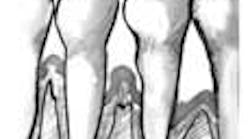Data from the National Health and Nutrition Examination Study (NHANES) 2009–2010 showed that the total prevalence of periodontitis in adults aged 30 years and older was 47.2% in the United States.(5) When the Centers for Disease Control and Prevention- American Academy of Periodontology case definitions were applied, the prevalence of mild, moderate and severe periodontitis was 8.7%, 30.0% and 8.5%, respectively.(1)
Bottom line. Educate patients about the link between a healthy mouth and healthy body. Prevention and periodontal therapy improve the oral condition, and may improve systemic conditions, as well.References 1. Chee B, Park B, and Bartold M. Periodontitis and type II diabetes: a two‐way relationship. International Journal of Evidence-Based Healthcare: December 2013 - Volume 11 - Issue 4 - p 317–329. 2. Paraskevas S, Huizinga JD, Loos BG. A systematic review and meta‐analyses on C‐reactive protein in relation to periodontitis. J Clin Periodontol, 2008; 35: 277–290. 3. Holman RR, Paul SK, Bethel MA, Matthews DR, Neil HA. 10‐year follow‐up of intensive glucose control in type 2 diabetes. N Engl J Med, 2008; 359: 1577–1589. 4. Teeuw WJ, Gerdes VEA, and Loos BG. Effect of Periodontal Treatment on Glycemic Control of Diabetic Patients- A systematic review and meta-analysis. Diabetes Care. February 2010 vol. 33 no. 2 421-427. 5. Eke PI, Dye BA, Wei L, Thornton‐Evans GO, Genco RJ. Prevalence of periodontitis in adults in the United States: 2009 and 2010. J Dent Res, 2012; 91: 914–920. 6. Nibali L, Tatarakis N, Needleman I, Tu YK, D'Aiuto F, Rizzo M, Donos N. Clinical review: Association between metabolic syndrome and periodontitis: a systematic review and meta-analysis. J Clin Endocrinol Metab. 2013 Mar;98(3):913-20. doi: 10.1210/jc.2012-3552. Epub 2013 Feb 5. 7. Engebretson SP, Hyman LG, Michalowicz BS, Schoenfeld ER, Gelato MC, Hou W, Seaquist ER, Reddy MS, Lewis CE, Oates TW, Tripathy D, Katancik JA, Orlander PR, Paquette DW, Hanson NQ, and Tsai MY. The Effect of Nonsurgical Periodontal Therapy on Hemoglobin A1cLevels in Persons With Type 2 Diabetes and Chronic Periodontitis. JAMA, 2013; 310 (23): 2523 8. The JAMA Network Journals. "Nonsurgical treatment of periodontitis for diabetics does not improve glycemic control." ScienceDaily. ScienceDaily, 17 December 2013. www.sciencedaily.com/releases/2013/12/131217170958.htm. 9. http://legiscan.com/CA/research/SB1000/2013. 10. http://news.yahoo.com/california-bill-seeks-warnings-sugary-drinks-222258256.html.












